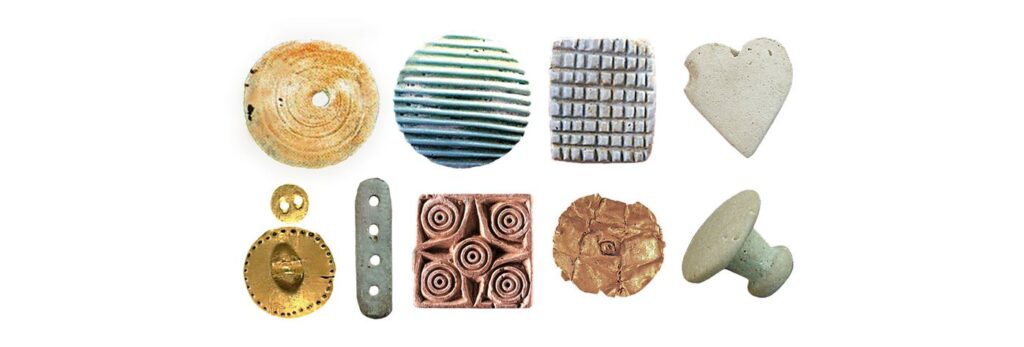I love taking classic clothing styles such as a good shirt and transforming them into something special. An unexpected mix of fabrics; a new sleeve shape; unusual buttons and trims; a play on proportions – it’s all about experimenting, creating, and having fun with new ideas!

Original button-front shirt design from 2017. Ties are made from muslin fabric to test the design concept. This is the starting point for my 2024 shirt design.
My first design of 2024 is a button-front shirt. I started with an original button-front shirt design I created in 2017 – a tried-and-true one! – and have been playing around with the sleeves, adapting the classic cuff for a short-sleeve style, and experimenting with shaping by adding extra gathers in the back to create a more “billowy” effect.
As different ideas for the 2024 shirt began to percolate, I fell down a research rabbit hole and discovered some interesting tidbits about shirts. I’m a history nerd so I just love this stuff!
Buttons for the rich and famous
The earliest buttons discovered to date are roughly 9000 years old and were discovered in present-day Pakistan. They were made of shells and were likely used primarily for ornamentation. It wasn’t until the 13th century, when buttonholes were developed, that buttons began to be widely used as garment fasteners. Over time, buttons and buttonholes became indispensible, because they allowed garments to fit more closely to the body, stayed closed, and were decorative as well as functional.
From the beginning, they were highly coveted, with restrictions placed based on wealth and rank. Nobles could commission buttons made of gold, silver, and precious stones, but everyone else had to settle for buttons made of bone, wood, and coarse fabric. In one example of excess, King Louis XIV of France (aka Marie Antoinette’s husband) was said to have a favorite coat adorned with 123 diamond buttons and buttonholes embellished with diamonds!

Image and caption from here. A drilled shell disc estimated to date from 7000 bce, top left, is the oldest-known buttonlike object. It was discovered at Mehrgarh in the Indus Valley, now in Pakistan, where other button-like objects, top two rows, have been found also at Harrapa, made variously from shells, gold, steatite and faience and dated mostly between 2600 and 1900 bce. These were used for decoration, not garment closures like buttons today, says archeologist J. Mark Kenoyer.
Why men’s and women’s shirts button on opposite sides
There are a number of theories as to why men’s and women’s garments button on opposite sides — men’s garments have buttons on the right side and women’s garments have buttons on the left side. The most popular view is that, because wealthy women wore elaborate garments that required servants to help them, buttons were placed on the left side of the garment to make it easier to dress. While this way of dress no longer applies to us today, the convention still remains. Personally, I’m so used to having the buttons on the left side that, when I do run into a situation where the buttons are on the right, I find it really strange and awkward!
Button-down shirts and polo players
Button-down shirts were developed in the late 19th century by John E. Brooks, whose grandfather had founded Brooks Brothers. While on a trip to England, he watched a polo match and noticed that the players’ shirt collars were buttoned down to prevent them from flapping up. He liked the attractive “rolled collar” effect and brought the idea back to the company. In 1896, Brooks Brothers introduced the first button-down shirt and an icon was born.
Diversion over — now back to work on the 2024 shirt! Check out my Design Gallery for some of my shirt and top designs!

Leave a Reply